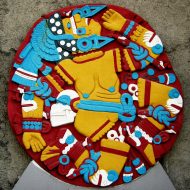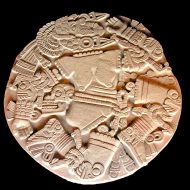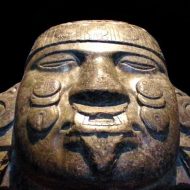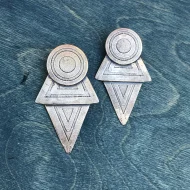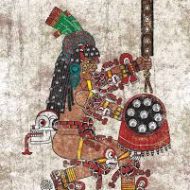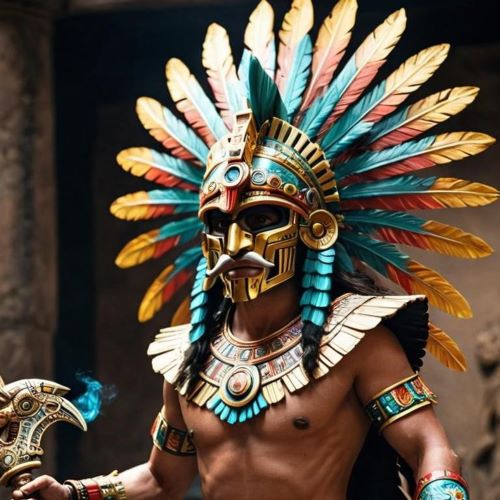Coyolxauhqui : The Moon Goddess
Listen
At a glance
| Description | |
|---|---|
| Origin | Aztec Mythology |
| Classification | Gods |
| Family Members | Coatlique (Mother), Huitzilopochtli, Centzon Huitznahua (Siblings) |
| Region | Mexico |
| Associated With | Moon, Battle |
Coyolxauhqui
Introduction
Coyolxauhqui, pronounced as Koy-ol-shauw-kee, holds a prominent role in Aztec mythology, recognized as the goddess of the Moon or Milky Way. Her narrative is notably immortalized in a sizable relief stone located at the base of the pyramid of sacrifices, the Templo Mayor, situated in the Aztec capital of Tenochtitlan. This enigmatic figure emerges as a poignant symbol of cosmic power and rebellion within the Aztec pantheon. In her capacity as the moon goddess, she embodies the cyclical essence of time, skillfully wielding both beauty and ferocity.
Physical Traits
Unearthed in 1978, the Coyolxauhqui stone serves as a visual representation of the goddess. This remarkable artifact boasts a diameter of approximately eleven feet and portrays Coyolxauhqui adorned with golden bells on her cheeks, feathers, and tufts of down embellishing her hair. The goddess is depicted wearing elaborate earrings, fanciful sandals, and bracelets, creating a captivating portrayal of her divine presence.
Coyolxauhqui, translating to “adorned with bells,” is commonly depicted as a youthful woman exuding striking beauty. While interpretations may differ, the prevailing image showcases her dark, flowing hair interwoven with tinkling bells, symbolizing her affiliation with the moon. Her countenance, painted with nocturnal symbols, signifies both her celestial lineage and her inherent warrior spirit. The serpent-skin loincloth she wears, a hallmark of Aztec elite attire, serves as a tangible reminder of her earthly connections amid her ethereal nature.
Despite her elegant depiction, Coyolxauhqui’s body is sometimes portrayed as dismembered and fragmented, a poignant representation of the perpetual dance she engages in on the celestial threshold. This dynamic portrayal underscores the cosmic struggle embedded in Aztec mythology, where beauty and violence coalesce in the goddess’s eternal performance. The meticulous detailing of her regalia, featuring a skirt crafted from serpents and a sash adorned with hearts, stands as a testament to the Aztecs’ artistic mastery in capturing the essence of their deities.
Family
Coyolxauhqui, recognized as the daughter of the priestess Coatlicue, also known as “Serpent Skirt,” emerges from a family with a captivating and dramatic lineage. In this intricate tapestry of relationships, she shares kinship with Huitzilopochtli, the national deity of the Mexicas, and the Centzon Huitznahua, a group of 400 celestial stars who are her brothers.
The family dynamics surrounding Coyolxauhqui play a pivotal role in shaping her mythological significance in Aztec culture. Born to Coatlicue, the earth goddess, and sister to Huitzilopochtli, the formidable god of war and the sun, Coyolxauhqui embodies both the celestial and earthly realms within her being. Leading the Centzon Huitznahua further adds layers to her divine identity.
The myth that surrounds Coyolxauhqui’s birth is a poignant narrative marked by tragedy and symbolism. According to Aztec lore, Coatlicue conceived after a ball of feathers descended from the heavens and touched her. In response to their mother’s unexpected pregnancy, Coyolxauhqui and her siblings, driven by a sense of disgrace, resolved to end Coatlicue’s life. However, the tale takes a dramatic turn as Huitzilopochtli emerges fully armed from his mother’s womb, fiercely defending Coatlicue. In the cosmic struggle that ensues, Huitzilopochtli ultimately beheads Coyolxauhqui, casting her lifeless form down the steps of the Templo Mayor in Tenochtitlan.
This tragic episode not only reflects the intense familial conflicts within Aztec mythology but also symbolizes the eternal cosmic dance between life, death, and rebirth. Coyolxauhqui’s fate becomes a testament to the cyclical nature of existence, where destruction and creation are inseparable elements in the cosmic order of the Aztec worldview.
Other names
The name Coyolxauhqui finds its translation as “Painted with Bells,” a descriptor aptly mirroring her physical representation adorned with golden bells on her face. In the vast realm of Aztec mythology, Coyolxauhqui, like many other deities, goes by various names, each unraveling a distinct facet of her intricate nature.
Among her alternative appellations is “Yohuallatonacauhqui,” signifying “she who adorns the night sky.” This title underscores Coyolxauhqui’s celestial prowess, positioning her as a dominant presence in the cosmic expanse. Another name she bears is “Tlazolteotl,” translating to “goddess of filth.” This particular epithet draws attention to her connection with the underworld and the tumultuous forces of chaos. The coexistence of these contrasting names paints a vivid portrait of a goddess who traverses multiple realms, seamlessly existing both in the radiant embrace of the moon and the swirling shadows of the night.
Powers and Abilities
While the specific powers and abilities of Coyolxauhqui remain somewhat elusive in the available sources, her influence within Aztec mythology is undeniably substantial. Notably, she led the Centzon Huitznahua, her brothers, in an assault against their mother, Coatlicue. However, this attack was thwarted by the intervention of Huitzilopochtli.
In her role as the goddess of the moon, Coyolxauhqui exerts a profound influence over the night sky, shaping the ebb and flow of tides and weaving through the ethereal realm of dreams. Her realm of control extends to the transformative forces of nature, symbolizing the cyclical waxing and waning of the moon. While her primary association lies with lunar magic, certain accounts draw connections between Coyolxauhqui and the formidable, destructive forces of nature, such as earthquakes and floods.
However, the defining attribute of Coyolxauhqui lies in her resolute warrior spirit. Leading her brothers into battle, she embodies the valor and strategic acumen essential for navigating the tumultuous expanses of the night. Her symbolism transcends the lunar domain, weaving into broader themes of fertility and cosmic equilibrium. The serpents adorning her skirt evoke a dual sense of danger and regeneration, illustrating the intricate interplay between life and death in Aztec cosmology. The hearts embellishing her sash further accentuate the sacrificial dimension of Aztec religious practices, where offerings were made to sustain the delicate balance of the cosmic order. Coyolxauhqui’s multifaceted symbolism thus reflects the complex interconnections inherent in the tapestry of Aztec mythology.
Modern Day Influence
The unearthing of the Coyolxauhqui stone in 1978 triggered an extensive excavation to reveal the Templo Mayor in Mexico City. Positioned prominently, the stone’s significance lies in depicting Coyolxauhqui’s defeat by Huitzilopochtli, underscoring its importance in Aztec religion and national identity. Today, the Templo Mayor and the Coyolxauhqui stone stand as crucial archaeological sites, offering valuable insights into Aztec history and culture.
Coyolxauhqui’s impact transcends the boundaries of ancient Aztec culture. Her image, notably featured on the Templo Mayor’s sacrificial stone, continues to inspire artists and scholars alike. In contemporary interpretations, her representation resonates within feminist discourse, delving into themes of female power and the intricate facets of womanhood.Furthermore, Coyolxauhqui’s narrative has evolved into a wellspring of inspiration for feminist reinterpretations of mythology. Scholars and artists delve into her defiance and courage, reclaiming her story as a symbol of female strength and resistance against patriarchal oppression.
Within Mexican culture, Coyolxauhqui finds celebration during festivals and events that pay homage to the rich tapestry of pre-Columbian traditions. Her presence extends to murals, sculptures, and various forms of public art, serving as a potent reminder of the enduring strength of indigenous spirituality amid the challenges of cultural assimilation.
In the realm of popular culture, Coyolxauhqui’s influence reverberates through literature, film, and music. Contemporary storytellers draw upon her myth to craft narratives exploring themes of identity, power dynamics, and the cyclical nature of existence. The enduring presence of this goddess in the cultural landscape attests to the timeless allure of Aztec mythology and its capacity to resonate with diverse audiences across different mediums.
Related Images
Frequently Asked Questions
What is lorem Ipsum?
I am text block. Click edit button to change this text. Lorem ipsum dolor sit amet, consectetur adipiscing elit. Ut elit tellus, luctus nec ullamcorper mattis, pulvinar dapibus leo.
What is lorem Ipsum?
I am text block. Click edit button to change this text. Lorem ipsum dolor sit amet, consectetur adipiscing elit. Ut elit tellus, luctus nec ullamcorper mattis, pulvinar dapibus leo.
What is lorem Ipsum?
I am text block. Click edit button to change this text. Lorem ipsum dolor sit amet, consectetur adipiscing elit. Ut elit tellus, luctus nec ullamcorper mattis, pulvinar dapibus leo.
What is lorem Ipsum?
I am text block. Click edit button to change this text. Lorem ipsum dolor sit amet, consectetur adipiscing elit. Ut elit tellus, luctus nec ullamcorper mattis, pulvinar dapibus leo.
What is lorem Ipsum?
I am text block. Click edit button to change this text. Lorem ipsum dolor sit amet, consectetur adipiscing elit. Ut elit tellus, luctus nec ullamcorper mattis, pulvinar dapibus leo.

